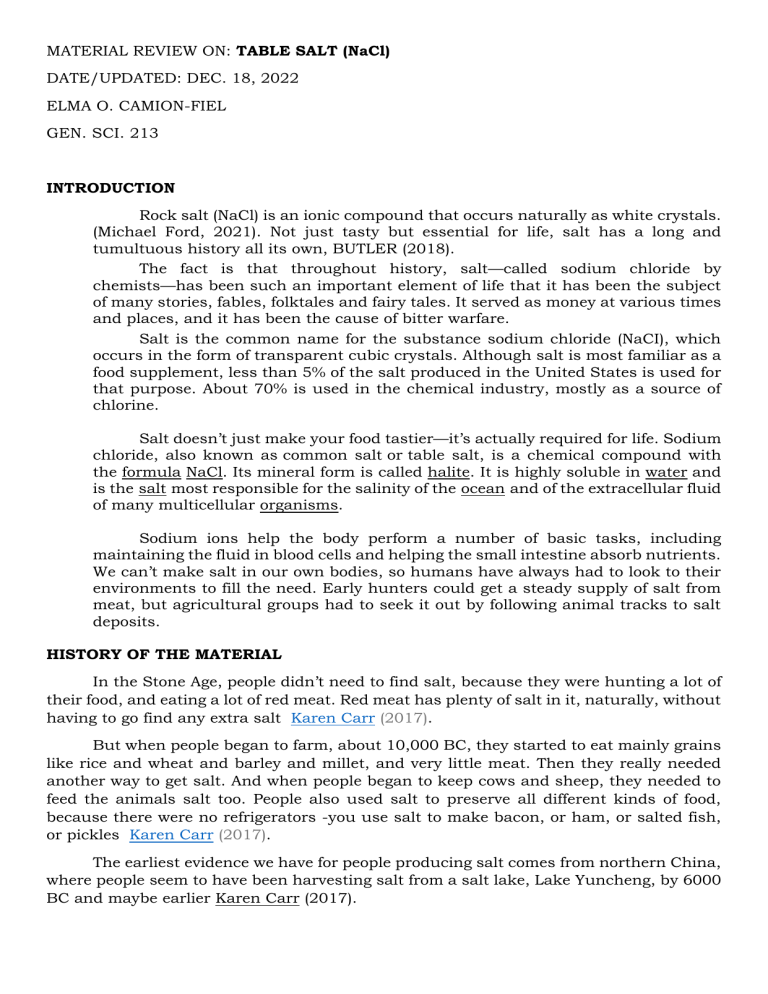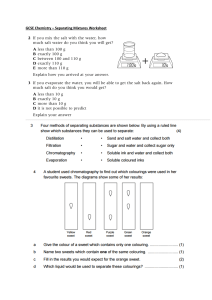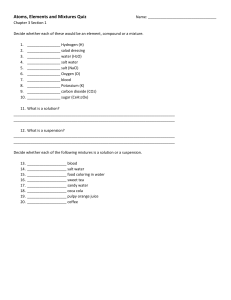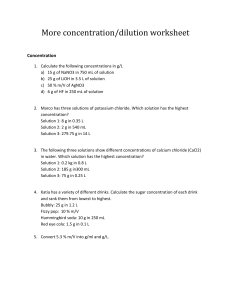
MATERIAL REVIEW ON: TABLE SALT (NaCl) DATE/UPDATED: DEC. 18, 2022 ELMA O. CAMION-FIEL GEN. SCI. 213 INTRODUCTION Rock salt (NaCl) is an ionic compound that occurs naturally as white crystals. (Michael Ford, 2021). Not just tasty but essential for life, salt has a long and tumultuous history all its own, BUTLER (2018). The fact is that throughout history, salt—called sodium chloride by chemists—has been such an important element of life that it has been the subject of many stories, fables, folktales and fairy tales. It served as money at various times and places, and it has been the cause of bitter warfare. Salt is the common name for the substance sodium chloride (NaCI), which occurs in the form of transparent cubic crystals. Although salt is most familiar as a food supplement, less than 5% of the salt produced in the United States is used for that purpose. About 70% is used in the chemical industry, mostly as a source of chlorine. Salt doesn’t just make your food tastier—it’s actually required for life. Sodium chloride, also known as common salt or table salt, is a chemical compound with the formula NaCl. Its mineral form is called halite. It is highly soluble in water and is the salt most responsible for the salinity of the ocean and of the extracellular fluid of many multicellular organisms. Sodium ions help the body perform a number of basic tasks, including maintaining the fluid in blood cells and helping the small intestine absorb nutrients. We can’t make salt in our own bodies, so humans have always had to look to their environments to fill the need. Early hunters could get a steady supply of salt from meat, but agricultural groups had to seek it out by following animal tracks to salt deposits. HISTORY OF THE MATERIAL In the Stone Age, people didn’t need to find salt, because they were hunting a lot of their food, and eating a lot of red meat. Red meat has plenty of salt in it, naturally, without having to go find any extra salt Karen Carr (2017). But when people began to farm, about 10,000 BC, they started to eat mainly grains like rice and wheat and barley and millet, and very little meat. Then they really needed another way to get salt. And when people began to keep cows and sheep, they needed to feed the animals salt too. People also used salt to preserve all different kinds of food, because there were no refrigerators -you use salt to make bacon, or ham, or salted fish, or pickles Karen Carr (2017). The earliest evidence we have for people producing salt comes from northern China, where people seem to have been harvesting salt from a salt lake, Lake Yuncheng, by 6000 BC and maybe earlier Karen Carr (2017). By about 4500 BC, Central Asian people along the shores of the Caspian Sea (in modern Azerbaijan) were mining rock salt underground. This is the earliest known salt mine in the world. Probably these people were selling the salt along early Silk Road trade routes, perhaps in exchange for copper or obsidian, wheat from West Asia and milletfrom China, Karen Carr (2017). In Egypt, people were using salt to preserve meat and fish by about 3000 BC, around the beginning of the Old Kingdom. The Egyptians also used salt to preserve mummies. They evaporated seawater from the Mediterranean Sea, and also bought salt from Libya, Sfax in Tunisia, and Nubia to their south. By 800 BC, Chinese written records tell us that people in China were producing salt by filling clay jars with ocean salt water and boiling it until the water boiled away and only the salt was left. After the Chinese learned how to make iron from West Asia, about 700 or 600 BC during the Eastern Chou dynasty, they started using iron pans instead of clay ones to boil water for salt; this saved a lot of fuel. They were definitely using iron pans by 450 BC. The Etruscans in Italy, and the early Romans, and the Carthaginians in North Africa, also used evaporation to produce salt. About the same time (700 BC), in Europe, the Indo-European Celts were mining salt underground in modern Austria, Hungary, southern Germany and Poland. The Celts sold their salt to other people – the Greeks, the Etruscans, and the Carthaginians, maybe the Phoenicians. The Celts also sold salted meat – salami, ham, and bacon. In exchange, the Celts bought glass and pottery for their houses and their graves. INDUSTRIAL APPLICATION OF THE MATERIAL CLEANING AND SAFETY As far as chemicals go, salt is about as versatile as it gets. Here are a few of the ways salt is used to promote cleaning and safety across industries: A. Detergents: Soaps, detergents, and solvents contain salt as a filler. When several chemicals are present, salt separates the chemicals so they can perform their specific tasks. B. Chlorine production: Sodium chloride’s main industrial use is in the production of chlorine, a feedstock for plastics and other chemicals. C. Pool maintenance: Pools and spas are more frequently being outfitted with saltwater systems, which gives the same water sanitation as chlorine while reducing chlorine levels. D. Water treatment: Salt flocculates calcium and magnesium, which softens water. E. Road maintenance: Industrial salt is an inexpensive method for controlling ice or melting ice on roads since it lowers water’s freezing point. As roads are maintained or constructed, salt added to soil binds it more tightly for a firmer surface. F. Food and beverage: In processed meats, salt enriches color, controls bacterial growth, binds sausage, and softens meat. For breads and dairy products, salt coordinates fermentation rates and enhances flavor. Flour contains salt to strengthen gluten and heighten flavor. MANUFACTURING A. Metallurgy: Metal processing creates abundant impurities. Salt removes the impurities during refining or smelting of aluminum, beryllium, copper, steel, vanadium, and uranium. B. Rubber synthesizing: In combination with sulfuric acid and water, industrial salt coagulates latex, thereby separating rubber from latex, to create neoprene and white rubber. C. Tanning: Salt reduces moisture and bacteria in the leather working process. 1. Use of Industrial Salt for De-Icing One of the most prevalent salt use cases is de-icing. When using de-icing rock salt, the application can help maintain roads, sidewalks, and other surfaces that can be potentially dangerous when a layer of ice is developed. This de-icing road salt is spread across the roads to create a layer of brine before the surface is able to freeze, helping to prevent or delay ice formation. In the case that the roadways or sidewalks are already covered with a layer of snow, the salt can be used to lower the water’s freezing point, helping to melt the snow and delay the ice formation. Industrial salt is an invaluable tool to keep roads safe and prevent accidents. 2. Salt Applications in the Oil Industry The use of salt is also common in the oil industry. In many cases, it is used in an oil drilling rig to make it safer and more efficient. It can also be used as an additive in mud when used as a drilling fluid. Here is an explanation of how industrial salt is used in the oil industry: It increases the density of the soil and makes the drilling process safer; When used in mud as a drilling fluid, it acts as a lubricant and coolant for the drilling head; Salt applications can be used as diverting agents, flocculants, stabilizers, acidizing specialty additives, and thinners/dispersants. 3. Industrial Salt in the Energy Industry Another example of what is salt used for applies to the energy industry. When producing energy such as solar power, the process itself requires industrial salt. This helps to maintain a certain level of salinity that’s required for specific reactions to take place. 4. Uses of Salt in the Chemical Industry Industrial salt is also widely used in the chemical industry to produce different chemicals. It can be used as a raw material when manufacturing chemicals such as chlorine, soda ash, and caustic soda. In addition, industrial salt can be used to manufacture products such as sodium nitrate, sodium bicarbonate, liquid sodium, metallic sodium, sodium sulfate, and more. 5. Industrial Salt for Electrolysis Industrial salt can be used to create chlorine, know that it is a primary component of disinfection and hygiene products. Chlorine production stems from the electrolysis of a saturated salt solution, making sodium chloride the raw material when producing chlorine. For example, Turkey’s largest salt producer Koyuncu Salt offers industrial salt for many industrial uses such as in the chlor alkali industry. 6. Salt Uses in the Metal Industry The use of salt in the metal industry is also common. In many cases, industrial salt is used while processing metals and secondary aluminum making to remove the impurities. 7. Salt for the Textile Industry In the textile industry, it’s common for industrial salt to be used for textiles to fix batches of dye. This allows the textile industry to achieve standardized dye. 8. Salt in the Pharmaceutical Industry Another use of salt is in the pharmaceutical industry. Salt is an ingredient that is commonly used to prepare saline solutions as well as in the production of capsules. Industrial salt is used to make intravenous formulas, contact solutions, and many more products in the pharma industry. 9. Salt in the Soap Industry Sodium chloride in soap is also common as industrial salt is commonly used as an additive filler in solvents and detergents. Salt is often added as a filler to easily separate the chemicals. 10. Salt for Water Treatment Water treatment refers to removing contaminants and undesirable components. It also reduces the water’s concentration for industrial water supply and plays an important role in providing humans with clean water for drinking and bathing. Water softening salt can be used for both domestic and industrial purposes including regeneration salt and dishwasher salt. 11. Salt for the Food Industry Salt in the food industry helps to cure and preserve meat and fish for thousands of years. It is a simple yet impactful way to preserve food for humans around the world. As soon as salt is applied to meat or fish, it draws out the moisture to prevent bacteria growth, preserving it for weeks at a time. Many microorganisms cannot live in an overly salty environment: water is drawn out of their cells by osmosis. For this reason, salt is used to preserve some foods, such as smoked bacon or fish, and can also be used to detach leeches that have attached themselves to feed. In processed meats, salt enriches color, controls bacterial growth, binds sausage, and softens meat. For breads and dairy products, salt coordinates fermentation rates and enhances flavor. Flour contains salt to strengthen gluten and heighten flavor. 12. Salt in Agriculture Another industrial use for salt is in agriculture. For example, silage is a forage preservation technique that requires spontaneous lactic acid fermentation under anaerobic conditions. In many countries, silages are used as animal feed, and salt preserves forage and are used to increase the rate of acidification and extend the shelf life. It limits bacterial growth and preserves its nutritional properties. 13. Salt as a Dust Control Solution Did you know that salt can also be used to control dust on unpaved roads? Most commonly used is Calcium Chloride; it works to absorb the moisture in the air and minimizes the production and spread of dust. Calcium chloride has a higher concentration and it remains in liquid form even on particularly hot and dry days. Magnesium chloride can also be used to control dust by removing moisture from the air to reduce the movement of dust particles. It acts as a road stabilizer and allows the dust to stick to the road. RECENT APPLICATION OF THE MATERIAL This material is used daily especially in Food Industry. CURRENT RESEARCHES ON THE MATERIAL (2018-PRESENT) 1. Effect of Sodium Chloride Concentration on Saturated Permeability of Remolded Loess (2020) Loess contains many sodium and chloride ions that can easily be leached when seepage occurs, thus affecting the mechanical properties of loess. This study investigated a series of sodium chloride solution concentrations to explore their influence on the permeability of remolded loess, as well as the underlying mechanism of such. The results indicated that the saturated hydraulic conductivity of remolded loess increases with time in response to different sodium chloride concentrations, and the sample was more permeable with increasing concentration. Moreover, the salt effect promoted the dissolution of calcite and dolomite, and the cation exchange stimulated the leaching of other cations, thus leading to further structural loosening. Furthermore, the aggregation of clay particles increased, thus forming a larger pore space among aggregates and providing effective channels for permeation. These findings provide a theoretical basis for an improved understanding of channel degradation in the loess area of Northwest China. 2. The role of sodium chloride in the sensory and physico-chemical properties of sweet biscuits (2020) Salt is included in many foods which consumers do not regard as salty. This “hidden-salt” may offer functional benefits but is often overlooked in sodium reduction strategies. This study investigated its role in shortbread-like sweet biscuits (1.05 g NaCl/100 g). Sensory tests revealed significant flavour and texture differences after a salt reduction of 33% (0.86 g/ 100 g). This was explained by differences in the partitioning of hydrophobic aroma compounds into the headspace and a significant impact on structure. Texture analysis and X-ray-µCT measurements revealed a reduced hardness with larger and more air cells in saltreduced biscuits. It is suggested that salt impacts on cereal proteins by altering their aggregation around flour particles and at bubble walls and that slower water loss occurs in salted matrices during baking. Hence, this study revealed the key properties significantly affected by salt reduction and proposes an explanation which will help to develop a targeted “hidden-salt” reduction strategy. 3. Effect of NaCl road salt on the ionic composition of soils and Aesculus hippocastanum L. foliage and leaf damage intensity (2021) We investigated the accumulation of sodium chloride in roadside soils and common horse chestnut Aesculus hippocastanum L. under urban conditions to evaluate changes in soil and leaf ionic content and their relationship with foliar damage, considering the visual assessment of trees of the same health status. A total of 15 field sites were assessed in late June 2016. The analysis included soil granulometric composition, pH, electrical conductivity, and the content of Cl− , Na+ , K+ , Ca2+, and Mg2+ ions in soil and foliage samples. The results showed increased salinity and alkalization of roadside soils together with the decreased magnesium content. Foliage samples manifested significantly higher concentrations of Na+ and Cl− . A wide range of Cl− content was noted in leaves (2.0–11.8% d.w.) regardless of their damage index. On the contrary, leaf damage was strongly correlated with increasing Na+ concentrations and decreasing K+ and Mg2+. A severe imbalance of nutrients, and therefore poor urban tree vitality, can be attributed to the excessive accumulation of de-icing salt. However, further research would be needed to clarify the discrepancy between the extent of leaf damage and chloride content. 4. Effects of NaCl Concentrations on Growth Patterns, Phenotypes Associated With Virulence, and Energy Metabolism in Escherichia coli BW25113 (2021) They investigated how NaCl concentrations influenced growth patterns, biofilm formation, oxidative stress resistance, and motile ability. In terms of energy metabolism that is central to bacterial survival, glucose consumption, glycogen accumulation, and trehalose content were measured in order to understand their roles in dealing with the fluctuation of osmolarity. According to the results, trehalose is preferred than glycogen at high NaCl concentration. In order to dissect the molecular mechanisms of NaCl effects on trehalose metabolism, we further checked how the impairment of trehalose synthesis pathway (otsBA operon) via singlegene mutants influenced E. coli durability and virulence under salt stress. After that, we compared the transcriptomes of E. coli cultured at different NaCl concentrations, through which differentially expressed genes (DEGs) and differential pathways with statistical significance were identified, which provided molecular insights into E. coli responses to NaCl concentrations. In sum, this study explored the in vitro effects of NaCl concentrations on E. coli from a variety of aspects and aimed to facilitate our understanding of bacterial physiological changes under salt stress, which might help clarify the linkages between bacterial durability and virulence outside hosts under environmental stresses. - Li F, Xiong X-S, Yang Y-Y, Wang J-J, Wang M-M, Tang J-W, Liu Q-H, Wang L and Gu B (2021) Effects of NaCl Concentrations on Growth Patterns, Phenotypes Associated With Virulence, and Energy Metabolism in Escherichia coli BW25113 SIGNIFICANCE OF THE MATERIAL ON THESIS/DISSERTATION PREPARATION I choose SALT(NaCl) for my material review mainly because: 1. I am planning to study on water quality in our community because of scarcity of drinking water resources in our place despite the fact that it is located in mountain area where is abundant supply of water. 2. Salinity is one of the of the parameters to be checked when checking water quality and salt is the reason for salinity. 3. This material will greatly give benefits is used widely in every aspect of our daily life. STRUCTURE OF THE MATERIAL The structure of NaCl is formed by repeating the face centered cubic unit cell. It has 1:1 stoichiometry ratio of Na:Cl with a molar mass of 58.4 g/mol. Compounds with the sodium chloride structure include alkali halides and metal oxides and transition-metal compounds, Osborne, et al (2022). The crystal structure of sodium chloride, NaCl, a typical ionic compound. The smaller purple spheres represent sodium cations, Na+, and the larger green spheres represent chloride anions, Cl−Cl−. The unit cell of NaCl consists of Na+ ions and Cl− ions. There are four types of site: unique central position, face site, edge sites and corner site, which are used to determine the number of Na+ ions and Cl- ions in the unit cell of NaCl. When counting the number of ions, a corner site would be shared by 7 other unit cells. Therefore, 1 corner would be 1/8 of an ion. A similar occurrence happens with the face site and the edge sites. For a face site, it is shared by 1 other unit cell and for an edge site, the ion is shared by 3 other unit cells. NaCl is a face centered cubic unit cell which has four cations and four anions. This can be shown by counting the number of ions and multiplying them in relation to their position PROPERTIES OF THE MATERIAL PROCESSES INVOLVED IN THE MANUFACTURE OF THE MATERIAL Processing rock salt Underground salt deposits are usually discovered by prospectors searching for water or oil. When salt is detected, a diamond-tipped, hollow drill is used to take several regularly spaced core samples throughout the area. When a site is selected for mining, shafts are sunk into the center of the salt deposit. Then a machine that looks like a gigantic chain saw is used to cut a slot about 6.0 inches (15 cm) high, about 66 feet (20 m) wide, and about 10 feet (3 m) deep into the salt at floor level. Chunks of blasted rock salt are transported to an underground crushing area. Here they are passed over a grating known as a grizzly which collects pieces smaller than about 9 inches (23 cm). Processing brine The simplest method of evaporating brine is solar evaporation, but it can only be used in hot, dry, sunny places. The brine is collected into shallow ponds and allowed to evaporate in the sun. The brine is collected into shallow ponds and allowed to evaporate in the sun. The salt is scooped up by machines running on temporary railroad tracks laid on top of the layer of salt. It is then washed with highly concentrated salt water. Most brine is processed by a multiple-effect vacuum evaporator. This device consists of three or more closed metal cylinders with conical bottoms. Brine may also be processed in a grainer. The brine is chemically purified and pumped into a long open pan heated by steam running through pipes immersed in the brine. The brine is heated to a temperature slightly below the boiling point and flakes of salt form on its surface as it evaporates. At this point salt used for most purposes is ready to be packaged in bags or boxes and shipped to consumers. To make iodized table salt, however, potassium iodide is added, then magnesium carbonate, calcium silicate, calcium phosphate, magnesium silicate, or calcium carbonate is added to make it free-flowing. The salt is then packaged and shipped to restaurants and grocery stores. Deep-Shaft Mining: Like mining for any other mineral, salt exists as deposits in underground ancient sea beds, typically miles long and thousands of feet deep. Most “rock salt” (used to de-ice highways and walkways) is produced this way. Solution Mining: Wells, similar to oil and gas wells, are set up over salt deposits, and fresh water is injected to dissolve the salt. The brine is then pumped out and taken to a plant for evaporation. Solar Evaporation: The oldest salt production method in warmer climates, salt is first captured in shallow ponds, where the wind and sun evaporate the water. The salt is then harvested either by hand or by machine. Quality Control Specifications for salt vary widely according to the intended use. Salt intended for human consumption must be much purer than salt used for melting snow and ice, but salt used for certain scientific purposes may need to be even purer. For most purposes, rock salt is allowed to have a gray, pink, or brown tinge rather than being pure white. The impurities that cause these colors may make up as much as 4% of a test sample. To test solubility, a 0.7-ounce (20 g) sample is placed in 6.8 fluid ounces (200 ml) of water. It should completely dissolve in no more than 20 minutes. REFERENCE (PROGRESSIVE) 1. The Industrial Applications of Salt — Bell Chem (2022) 2. Wood, F. Osborne , Ralston, . Robert H. and Hills, . John M. (2022, November 16). salt. Encyclopedia Britannica. https://www.britannica.com/science/salt 3. Carr, K.E. Where does salt come from?. Quatr.us Study Guides, June 23, 2017. Web. November 20, 2022. 4. Sheila Mesulam. Salt: Everything you wanted to know about this ancient, essential mineral, 1/30/2008 5. How salt is made - material, used, processing, procedure, industry, machine, Raw Materials (madehow.com) 6. History of Salt | SaltWorks® (seasalt.com)




